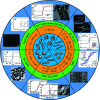Cancer treatment by magneto-mechanical effect of particles, a review
- PMID: 36132753
- PMCID: PMC9419242
- DOI: 10.1039/d0na00187b
Cancer treatment by magneto-mechanical effect of particles, a review
Abstract
Cancer treatment by magneto-mechanical effect of particles (TMMEP) is a growing field of research. The principle of this technique is to apply a mechanical force on cancer cells in order to destroy them thanks to magnetic particles vibrations. For this purpose, magnetic particles are injected in the tumor or exposed to cancer cells and a low-frequency alternating magnetic field is applied. This therapeutic approach is quite new and a wide range of treatment parameters are explored to date, as described in the literature. This review explains the principle of the technique, summarizes the parameters used by the different groups and reports the main in vitro and in vivo results.
This journal is © The Royal Society of Chemistry.
Conflict of interest statement
There are no conflicts to declare.
Figures





References
-
- Pankhurst Q. A. Connolly J. Jones S. K. Dobson J. P. Applications of magnetic nanoparticles in biomedicine. J. Phys. D: Appl. Phys. 2003;36:167–181. doi: 10.1088/0022-3727/36/13/201. - DOI
-
- Arruebo M. Fernández-pacheco R. Ibarra M. R. Santamaría J. Magnetic nanoparticles for drug delivery. Nano Today. 2007;2:22–32. doi: 10.1016/S1748-0132(07)70084-1. - DOI
Publication types
LinkOut - more resources
Full Text Sources
Other Literature Sources

